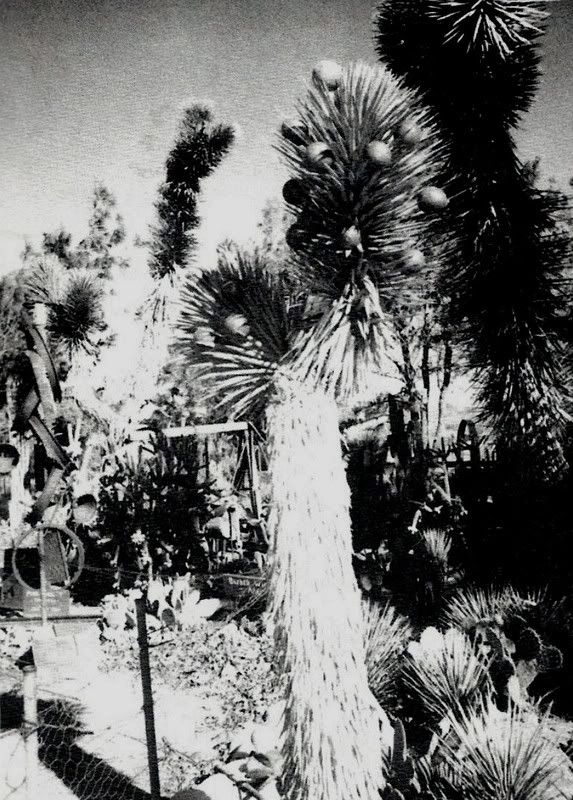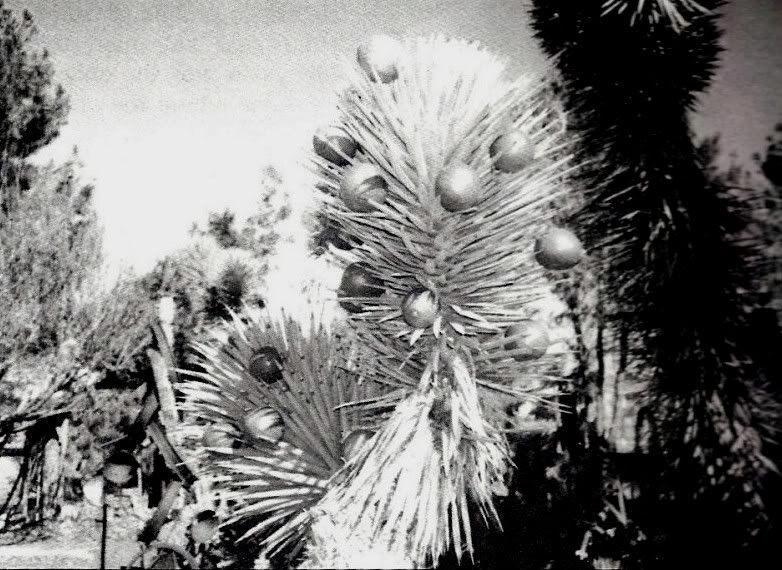
The orange harvest of ol' Hesperia
(Photo: Bits 'n Pieces of the Mohahve Sesert's Weathered Past, John M. Swisher; 1995)
From 1850 to 1856 ol' Los Angeles was very loosely and informally governed. Many of the day remembered life to be understandingly strenuous, but also easy and carefree. Historians said it was because of the excessive expression of individualism rather than organized political corruption. Then the first real estate boom arrived in 1885 and lasted through 1888. According to historian Horace Bell life suddenly made a reverse. "The banner of organized 'rescality' floated over the municipal hall of Los Angeles and its rulers were banded together in a speculative conspiracy against all that was honest."
The real estate boom was one of the bigger crimes of that century. Only a few profited by it, while many thousands became trapped into insane purchases of property and crazy land speculations. Finally, they were driven to ruin. Many areas in southern California were drawn into this real estate boom. a boom that was put into motion by false advertisement and much sly trickery. Two local areas that were caught in this questionable enterprise was the Cajon Pass and present day Hesperia (which was then called Widneyville-by-the-desert).
Robert Widney was the driving force behind selling land in present day Hesperia. None can really fault him, his motive was to provide a town for the growing California population. As the promoter in Hesperia (Widneyville), he was at the top of his game; "Welcome to Widneyville-by-the-desert! The modern Elysium!"
"Gee", one prospective land owner must of thought, "He's impressive, he appears to be speaking Greek." Sure enough, the phrase was Greek. Elysium was a section of the Underworld. The Elysian fields, or sometimes Elysian plains, were the final resting place of the souls of the heroic and the virtuous. But, to make the Mojave Desert appear to be "Elysium", a tremendous amount of fang-dangling had to be accomplished. Robert M. Widney organized a large excursion to shuttle the speculative hordes to the location of the proposed ideal city on its opening day. Live bands and large arrays of refreshment tables were set up. Who, even today, can refuse the chance of free food and free booze to wash it down with? The crowds arrived and the bidding on lots commenced.
It was the art of advertisin' that brought the crowds in and caused the lots to sale for thousands apiece; the scheme came afterwards, when the lots were assessed for taxation at $2, and many of them reverted to the tax collector.
So, what was the selling point of these properties? A natural (and to many of the eastern tenderfoots that brought early day Hesperia property) and rather appalling growth of cactus and Joshua Trees extended from horizon to horizon on the desert floor. It took awhile to get used to the spiny and writhing Joshua Tree. Especially if, while chasing a steer on a cowpony, you forgot to duck below their spiny and sharp branches. The promoters of Widneyville came up with a pretty nifty idea to save themselves the expense of clearing the innumerable Joshua Trees off all the lots. Don't remove them...just change their appearance. Soon, with a little trimming here and there, the yucca and Joshua Trees took on a certain look of uniformity.

(Photo: Bits 'n Pieces of the Mohahve Sesert's Weathered Past, John M. Swisher; 1995)
Then the promoters were ready for phase two of their ingenious plan. They shipped in carloads of wind-fall oranges, and on each bayonet-like spike on the yucca and Joshua Trees they impaled an orange. Like magic, the desert became an instant orange grove! Up and down the stake-out lots and proposed streets were "orange trees" loaded with a large harvest! Ahh...finally, Elysium! Prospective buyers, mostly easterners, stood agape at the sight, hardly listening to the words of the salesmen.
"Here, you see, ladies and gents, is the natural home of the orange, "shared the organizer of the sales excursion as he addressed the assembled multitude. "These beautiful trees, so prolific of fruit, are a natural growth! This is the only spot west of the Rocky Mountains where the orange is indigenous." The prospective buyers were promised this: irrigation canals would be built all over the staked estate tract, and when the "orange trees" grew, they would grow as big as pumpkins. There would be a fortune to be made in every block! There was a fortune in every block, just not for the buyer. Blocks and blocks of land were sold from the plat of "Widneyville-by-the desert", but no houses were ever built on the actual site. As for this land deal, many in the 1880's fell for it hook-line and sinker.
Advertising had proven to be an art form, for it had to attract overseas buyers as much as national and local buyers. Who cares if oversea buyers were gullible enough to fall for false advertisement. It sure was nice of them to come the extra mile to buy something. Case in point was the Cajon Pass, where early day advertisement showed that it was a large river inlet! Sales pamphlets showed steamboats traveling through the San Bernardino Valley and up and down a large mighty river in Cajon Pass. The Drexel heirs of England had come across the great sea to buy the land sight unseen on the strength of the advertisement. When they saw that it was just desert property, they promptly returned to England. Thank goodness for that! Had they stayed, a piece of interesting history might not have seen the light of day for our local area.
Ezra Meeker, the pioneer who made the Oregon Trail famous, brought his son, Marion, to the area long ago. It was Marion, who in 1918, secured the old Drexel land deeds. The Drexel clan let the land go but still had the tax titles. Meeker secured quick-claim deeds and obtained the area that would later be known as Meeker's. Soon it became a store, then the Meeker's Gas Station that once sat near the entrance of William Bristol's Camp Cajon. Both locations are no longer here...but, both places forever secured an important place in local history.
The art of advertising exists today. Perhaps in Wrightwood and surrounding areas, the advertising carries a little bit more truth. Real estate folks advertise a place of peace and quiet; a place away from the city's hassle and bustle. That's true...the only thing that we have to worry about are the prospective buyers that bring the nose up with them.
Just a piece of local history
Terry G.
Sources:
Bits 'N Pieces of the Mohahve Desert's Weathered Past; John M. Swisher, copyright 1995
On the Old West Coast-Being further Reminiscences of a Ranger; Major Horace Bell, edited by Lanier Bartlett, Published by Grosset & Dunlap 1930
The Mountaineers; Pearl Comfort Fisher, Published by San Bernardino County Museum Association 1972